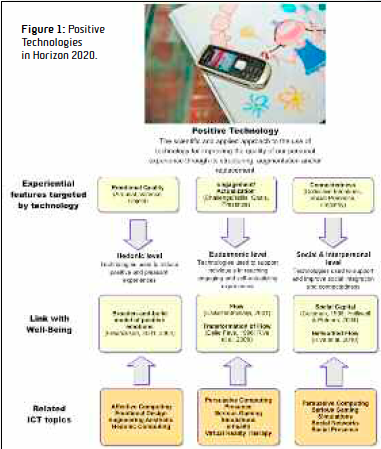By Giuseppe Riva
A significant part of the discussions related to the use of technology in our life starts with the same question: “What is wrong with technology?” This question, in all its possible formats, has guided the reflections of technology developers, designers, ergonomists, HCI experts, and psychologists during the last sixty years. Given the many shortcomings of the available digital tools, this question has produced a never-ending discussion around technology’s “dark side.”
Here we want to introduce a different question: “What is right about technology?”. This question is at the heart of the “Positive Technology” approach, which is the scientific and applied approach to the use of technology for improving the quality of our personal experience.
The emerging discipline of Positive Psychology provides a useful framework to address this challenge. Positive Psychology is the scientific study of optimal human functioning and flourishing. Instead of drawing on a “disease model” of human behavior, it focuses on factors that enable individuals and communities to thrive and build the best in life.
Positive Psychology identifies three characteristics of our personal experience – affective quality, engagement/actualization and connectedness – that serve to promote personal wellbeing. We suggest that it is possible to use technology to influence the above characteristics that serve to promote adaptive behaviors and positive functioning. In the proposed framework, positive technologies will be classified according to their effects on these three features of personal experience (see Figure 1):
- Hedonic: technologies used to induce positive and pleasant experiences;
- Eudaimonic: technologies used to support individuals in reaching engaging and self-actualizing experiences;
- Social/Interpersonal: technologies used to support and improve social integration and/or connectedness between individuals, groups, and organizations.
For each level it is possible to identify a set of critical variables – affect regulation for the Hedonic one, flow and presence for the Eudaimonic one; social presence, collective intentions and networked flow for the Social/Interpersonal one – that can be manipulated and controlled to guide the design and development of positive technologies. Specifically, technology can be used to manipulate these variables in three separate but related ways:
- By structuring it using a goal, rules and a feedback system: The goal provides subjects with a sense of purpose focusing attention and orienting his/her participation in the experience. The rules, by removing or limiting the obvious ways of getting to the goal, push subjects to see the experience in a different way. The feedback system tells players how close they are to achieving the goal and provides motivation to keep trying.
- By augmenting it to achieve multimodal and mixed experiences. Technology allows multisensory experiences in which content and its interaction is offered through more than one of the senses. It is even possible to use technology to overlay virtual objects onto real scenes.
- By replacing it with a synthetic one. Using VR it is possible to simulate physical presence in a synthetic world that reacts to the action of the subject as if he/she was really there. More, the replacement possibilities offered by technology even extend to the induction of an illusion of ownership over a virtual arm or a virtual body.
In conclusion, Positive Technology represents a new approach that tries to exploit the potential of new technologies to foster positive emotions, promote personal growth and support creativity, thereby contributing to social and cultural development.
Giuseppe Riva, Ph.D. Istituto Auxlogico Italiano Italy giuseppe.riva@unicatt.it auxo.psylab@auxologico.it
About Brenda Wiederhold
President of Virtual Reality Medical Institute (VRMI) in Brussels, Belgium.
Executive VP Virtual Reality Medical Center (VRMC), based in San Diego and Los Angeles, California.
CEO of Interactive Media Institute a 501c3 non-profit
Clinical Instructor in Department of Psychiatry at UCSD
Founder of CyberPsychology, CyberTherapy, & Social Networking Conference
Visiting Professor at Catholic University Milan.










